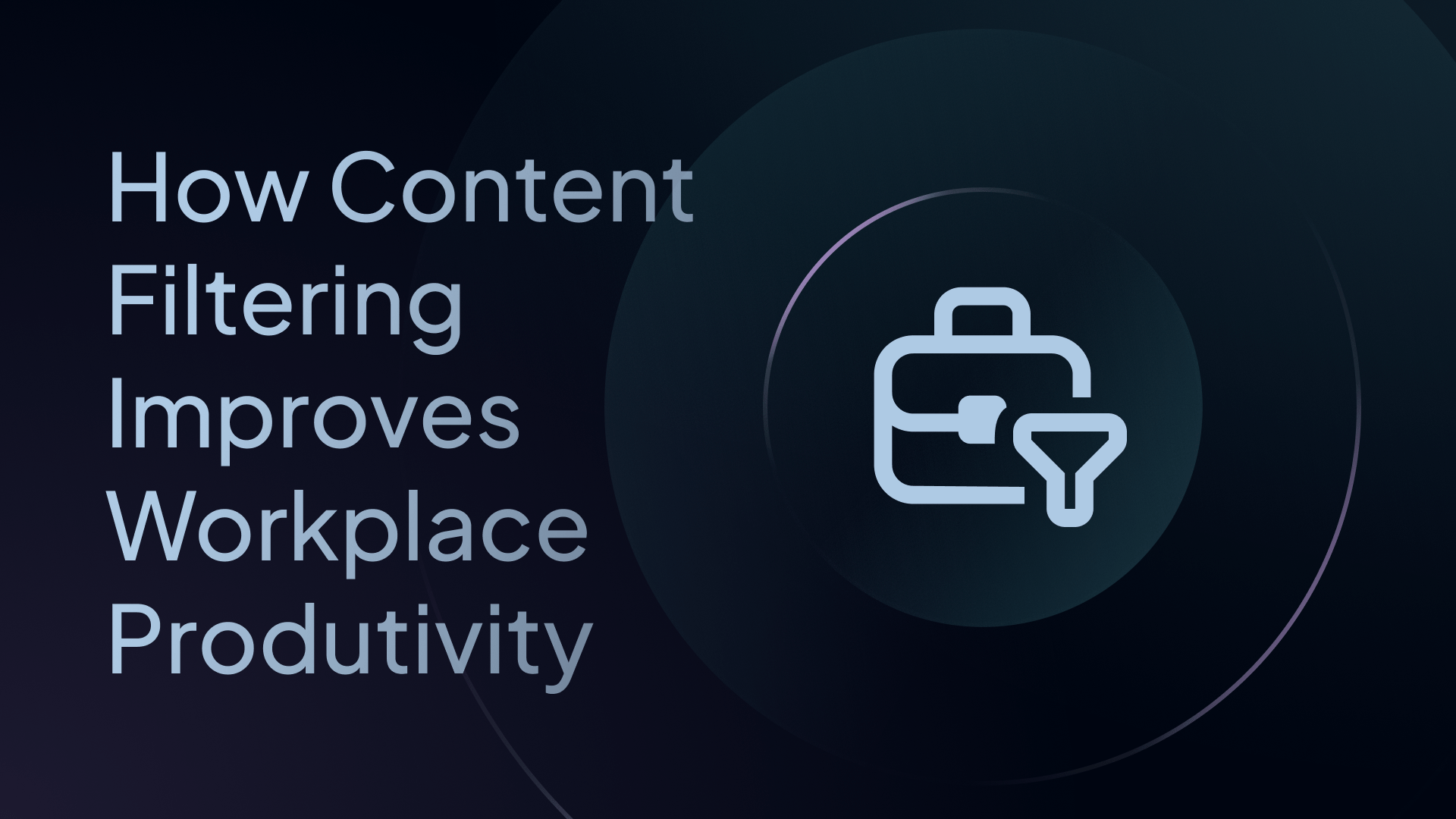Content filtering isn’t just about blocking cat videos or TikTok. It’s a strategic tool that helps businesses boost focus, protect bandwidth, and reduce digital distractions, all without treating employees like children.
Modern content filtering solutions like Control D give you the flexibility to create a distraction-free digital environment that actually works for your team.
In this post, we’ll break down how smarter content filtering drives real productivity gains in the workplace.
The Productivity Problem: Why Distractions Matter
According to research, nearly 80% of employees get distracted at least once every hour, with 11% distracted every five minutes. These interruptions aren’t just annoying – they’re expensive.
- The average employee loses 2.1 hours per day to distractions.
- This adds up to more than 700 hours per year per employee.
- Multiplied across a team or organization, the cost in lost productivity is staggering.
From social media scrolling to news rabbit holes, the modern workplace is a digital minefield of non-work-related content.
But unproductive time isn't just about laziness – it’s often a result of poor digital boundaries. And without visibility into how employees are using the internet during work hours, managers are essentially flying blind.
What Is Content Filtering and Why Does It Matter at Work?
Content filtering is a technology that blocks or restricts access to specific domains, categories of content, or types of online activity. It's most commonly implemented at the DNS level, firewall level, or through software agents.
Common content filtering categories include:
- Social Media
- Streaming & Entertainment
- Adult Content
- Gambling
- Gaming
- News & Media
- Ads & Trackers
- Malware & Phishing Domains
The goal is to prevent employees from accessing time-wasting or harmful content during work hours.
How Content Filtering Boosts Productivity
Let’s dig into how strategic content filtering can dramatically improve productivity in the workplace.
1. Eliminating Time-Wasting Sites
The most direct benefit is obvious: blocking distractions before they happen. Facebook, Instagram, TikTok, Reddit, and YouTube are powerful dopamine machines that are designed to keep users engaged far longer than intended.
By filtering these platforms during work hours, you can eliminate the temptation entirely. And this isn’t about being Orwellian – this is about helping employees stay in a flow state where real work gets done.
2. Reducing Context Switching
Every time someone gets distracted by a trending tweet or viral video, their brain has to reset. Studies show that it takes an average of 23 minutes to refocus after an interruption.
Content filtering helps maintain deep work by shielding employees from unnecessary digital noise.
3. Blocking Malicious or Inappropriate Content
Content filtering also protects against phishing sites, malware domains, adult content, and other inappropriate material. Besides being a productivity issue, access to these sites can expose companies to security breaches and legal liability.
Filtering protects your endpoints, your users, and your reputation.
4. Encourages Better Work Habits
With the proper boundaries in place, workers are more likely to adopt structured routines. Fewer online temptations = fewer opportunities to procrastinate.
5. Improving Network Performance
Video streaming, online gaming, and unauthorized downloads can hog bandwidth and slow down your network, especially in hybrid or co-working environments. Content filtering helps by blocking high-bandwidth sites, keeping your network snappy and responsive.
The Case Against Content Filtering: When It Backfires
Not all filtering strategies are created equal. In fact, overly aggressive or poorly implemented content filtering can harm productivity.
Here’s how.
1. Blocking Legitimate Work Resources
If your filtering tool is too rigid, it may inadvertently block useful websites like Slack integrations, developer documentation, or even customer feedback on social platforms. This leads to frustration, delays, and IT tickets.
Solution: Talk to your team and whitelist critical tools.
2. Hurting Morale and Trust
Employees don’t want to feel like they’re being spied on or treated like children. Draconian filtering policies can signal a lack of trust, which can reduce morale.
Solution: Use role-based filtering and allow reasonable access to non-work sites during breaks. Transparency is key – explain the why behind the policy.
3. One-Size-Fits-All Doesn’t Work
Your marketing team might need access to Instagram for competitive research. Your HR team might use YouTube for onboarding videos. Blanket bans can get in the way of legitimate use cases.
The key is granularity and flexibility, something many legacy filtering solutions lack.
Solution: Enable access or overrides for specific users or teams.
4. Workarounds and Shadow IT
If the policy is too restrictive, employees will find ways around it – using mobile data, proxies, or unauthorized VPNs. This creates security blind spots and compliance risks.
Solution: Choose a solution that balances control with flexibility, like Control D.
Control D: Smarter Content Filtering for the Modern Workplace
Traditional content filters had a reputation: too rigid, too broad, and too annoying. They’d block helpful research sites or collaboration platforms alongside actual time-wasters.
Modern filtering solutions, like Control D, are different.
Control D is a next-gen DNS filtering platform that puts customization, transparency, and control front and center. It lets you fine-tune your filtering setup to match your specific workplace needs, ensuring content filtering becomes a productivity enhancer, not a productivity killer.
Let’s break down how Control D helps organizations strike the right balance between productivity and autonomy.
1. Granular Policy Control
Control D’s Filters cover all broad content categories – from adult sites to video streaming, online gambling, and beyond. But there are also Services, which are 1,000 individual apps, tools, and vendors that you can block, redirect, or bypass.
This gives you granular control to tailor policies exactly to your needs with a single toggle.
2. Role-Based Filtering
Not all employees need the same level of access. Your marketing team might need Instagram; your dev team might need Stack Overflow.
Control D lets you create different filtering Profiles for different departments, job functions, or even individual users to ensure everyone has what they need (and only what they need) to stay productive.
3. Time-Based Rules
No need to be a tyrant; give employees the freedom to browse non-work sites before 9 AM, during lunch, or after 5 PM, but block those same sites during core working hours.
This reduces friction and builds trust while maintaining focus during the day. With Control D’s time-based rules, you don’t need to choose between “always on” or “always off”; you can have both.
4. Productivity-Driven Insights
If you opt into logging, Control D offers detailed analytics and reporting so you can see what categories or domains are being blocked, redirected, and bypassed. Again, this isn’t about surveillance, but about identifying bottlenecks and informed decision-making. You can:
- Spot trends (e.g., a spike in streaming traffic during work hours).
- Identify risky or inappropriate content access.
- Understand how different teams use the web.
These insights help you create smarter policies that drive focus without frustration.
5. Easy Setup and Management
Whether you’re configuring a few devices or rolling it out company-wide, Control D lets you get set up in minutes, not hours.
As a DNS-based solution, Control D can be deployed at scale using your preferred RMM tool, making mass rollout fast and efficient.
You can also take full advantage of the Control D API to automate user onboarding, apply filtering policies programmatically, and integrate with your existing systems.
No bloat, no micromanagement – just flexible, scalable filtering that works.
6. Security and Productivity – In One Tool
Control D doesn’t just help with productivity. It also blocks access to:
- Phishing and malware domains
- Botnets and malware C2 servers
- Suspicious ad networks
- Crypto mining domains
In one fell swoop, you’re boosting productivity and protecting your infrastructure.
Best Practices for Content Filtering That Work
If you’re considering content filtering – or you’re looking to improve your current setup – keep these best practices in mind:
✅ Involve Your Teams
Get input from different departments before setting policies. Understand their workflow and make sure filtering rules support productivity, not hinder it.
✅ Be Transparent
Let your team know why certain sites are blocked and how the policies work. Transparency builds trust and reduces pushback.
✅ Avoid Blanket Bans
Use Control D’s flexible rule system to set contextual policies. Block social media during work hours, not 24/7. Create exception lists for teams who need access. Or allow some leniency during breaks or after hours. It shows you trust your team while still protecting your core working hours.
✅ Monitor and Adapt
Use Control D’s analytics to tweak your setup over time. Filtering isn’t a “set it and forget it” solution. Your digital landscape changes, and your policies should, too.
Final Thoughts
If your team struggles with focus or you’re just tired of productivity slipping through the cracks, content filtering is a simple but powerful lever to pull.
When implemented with nuance, flexibility, and trust, it becomes one of the most effective tools in your productivity playbook.
Ready to take control of your team’s digital environment?



